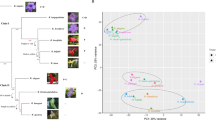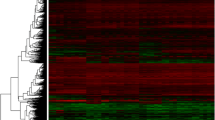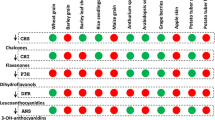Abstract
It has been argued that downstream enzymes in metabolic pathways are expected to be subject to reduced selective constraint, while upstream enzymes, particularly those at pathway branch points, are expected to exhibit more frequent adaptive substitution than downstream enzymes. We examined whether these expectations are met for enzymes in the anthocyanin biosynthetic pathway in Ipomoea. Previous investigations have demonstrated that downstream enzymes in this pathway have substantially higher rates of nonsynonymous substitution than upstream enzymes. We demonstrate here that the difference in rates between the most upstream enzyme (CHS) and the two most downstream enzymes (ANS and UFGT) is explained almost entirely by differences in levels of selective constraint. Adaptive substitutions were not detected in any of these genes. Our results are consistent with suggestions that constraint is greater on enzymes with greater connectivity.
Similar content being viewed by others
References
Bishop YMM, Feinberg SE, Holland PW (1975) Discrete multivariate analysis. MIT Press, Cambridge, MA
Chang SM, Lu Y, Rausher MD (2005) Neutral evolution of the nonbinding region of the anthocyanin regulatory gene Ipmyb1 in Ipomoea. Genetics 170:1967–1978
Cork JM, Purugganan MD (2004) The evolution of molecular genetic pathways and networks. Bioessays 5:479–484
Durbin ML, Lundy KE, Morrell PL, Torres-Martinez CL, Clegg MT (2003) Genes that determine flower color: the role of regulatory changes in the evolution of phenotypic adaptations. Mol Phylogenet Evol 29:507–518
Eanes WF (1999) Analysis of selection on enzyme polymorphisms. Annu Rev Ecol Syst 30:301–326
Excoffier L, Laval G, Schneider S (2005) Arlequin ver. 3.0: an integrated software package for population genetics data analysis. Evol Bioinform Online 1:47–50
Fay JC, Wyckoff GJ, Wu C-I (2001) Positive and negative selection on the human genome. Genetics 158:1227–1234
Flowers JM, Sezgin E, Kumagi S, Duvernell DD, Matzkin LM, Schmidt PS, Eanes WF (2007) Adaptive evolution of metabolic pathways in Drosophila. Mol Biol Evol 24:1347–1354
Fraser HB, Hirsh AE, Steinmetz LM, Scharfe C, Feldman MW (2002) Evolutionary rate in the protein interaction network. Science 296:750–752
Fukada-Tanaka S, Hoshino A, Hisatomi Y, Habu Y, Hasebe M, Iida S (1997) Identification of new chalcone synthase genes for flower pigmentation in the Japanese and common morning glories. Plant Cell Physiol 38:88–96
Hahn MW, Kern AD (2005) Comparative genomics of centrality and essentiality in three eukaryotic protein-interaction networks. Mol Biol Evol 22:803–806
Hahn MW, Rausher MD, Cunningham CW (2002) Distinguishing between selection and population expansion in an experimental lineage of Bacteriophage T7. Genetics 161:11–20
Hahn MW, Conant GC, Wagner A (2004) Molecular evolution in large genetic networks: does connectivity equal constraint? J Mol Evol 58:302
Hartl DL, Dykhuizen DE, Dean AM (1985) Limits of adaptation: the evolution of selective neutrality. Genetics 111:655–674
Hedrick PW (2000) Genetics of populations, 2nd edn. Jones and Bartlett, Sudbury, MA
Hirsh AE, Fraser HB (2001) Protein dispensability and rate of evolution. Nature 411:1046–1049
Hudson RR, Kreitman M, Aguadé M (1987) A test of neutral molecular evolution based on nucleotide data. Genetics 116:153–159
Kimura M (1977) Preponderance of synonymous changes as evidence for the neutral theory of molecular evolution. Nature 267:275–276
Kosakovsky Pond SL, Frost SDW (2005) Not so different after all: a comparison of methods for detecting amino acid sites under selection. Mol Biol Evol 22:1208–1222
LaPorte DC, Walsh K, Koshland DE (1984) The branch point effect: ultrasensitivity and subsensitivity to metabolic control. J Biol Chem 259:4068–4075
Lemos B, Bettencourt BR, Meiklejohn CD, Hartl DL (2005) Evolution of proteins and gene expression levels are coupled in Drosophila and are independently associated with mRNA abundance, protein length, and number of protein-protein interactions. Mol Biol Evol 22:1345–1354
Li WH (1997) Molecular evolution. Sinauer Associates, Sunderland, MA, p 185
Li WH, Wu CI, Luo CC (1985) A new method of estimating synonymous and nonsynonymous rates of nucleotide substitution considering the relative likelihood of nucleotide and codon changes. Mol Biol Evol 2:150–174
Lin YS, Hsu WL, Hwang JK, Li WH (2007) Proportion of solvent-exposed amino acids in a protein and rate of protein evolution. Mol Biol Evol 24:1005–1011
Lu Y (2002) Molecular evolution at the self-incomatpbility locus of Physalis longifolia (Solanaceae). J Mol Evol 54:784–793
Lu Y, Rausher MD (2003) Evolutionary rate variation in anthocyanin pathway genes. Mol Biol Evol 20:1844–1853
McClellan DA, Palfreyman EJ, Smith MJ, Moss JL, Christensen RG, Sailsberry JK (2005) Physicochemical evolution and molecular adaptation of the Cetacean and Artiodactyl cytochrome b proteins. Mol Biol Evol 22:437–455
McDonald JH, Kreitman M (1991) Adaptive protein evolution at the ADH locus in Drosophila. Nature 351:652–654
Pal C, Papp B, Hurst LD (2001) Highly expressed genes in yeast evolve slowly. Genetics 158:927–931
Rausher MD, Miller RE, Tiffin P (1999) Patterns of evolutionary rate variation among genes of the anthocyanin biosynthetic pathway. Mol Biol Evol 16:266–274
Rozas J, Sanchez-DelBarrio JC, Messeguer X, Rozas R (1999) DnaSP, DNA polymorphism analysis by the coalescent and other methods. Bioinformatics 19:2496–2497
Shapiro JA, Huang W, Zhang C, Hubisz MJ, Lu J, Turissini DA, Fang S, Wang H-Y, Hudson RR, Nielsen R, Chen Z, Wu C-I (2007) Adaptive genic evolution in the Drosophila genomes. Proc Natl Acad Sci USA 104:2271–2276
Shirley BW (1996) Flavonoid biosynthesis: ‘new’ functions for an ‘old’ pathway. Trends Plant Sci 1:377–382
Sokal RR, Rohlf JJ (1969) Biometry. The principles and practice of statistics in biological research. W. H. Freeman, San Francisco
Stephanopoulos G, Vallino JJ (1991) Network rigidity and metabolic engineering in metabolite overproduction. Science 252:1675–1681
Swanson WJ, Yang Z, Wolfner MF, Aquadro CF (2001) Positive Darwinian selection derives the evolution of several female reproductive proteins in mammals. Proc Natl Acad Sci USA 98:2509–2514
Tajima F (1989) Statistical method for testing the neutral mutation hypothesis. Genetics 123:585–595
Van der Meer IM, Stuitje AR, Mol HNM (1993) Regulation of general phenylpropanoid and flavonoid gene expression. In: Verma DPS (ed) Control of plant gene expression. CRC Press, Boca Raton, FL
Vitkup D, Karchenko P, Wagner A (2006) Influence of metabolic network structure and function on enzyme evolution. Genome Biol 7:R39
Watt WB, Dean AM (2000) Molecular functional studies of adaptive genetic variation in prokaryotes and eukaryotes. Annu Rev Genet 34:593–622
Whitefield L, Lovell-Badge R, Goodfellow P (1993) Rapid sequence evolution of the sex-determining gene SRY. Nature 364:713–715
Wyckoff GJ, Wang W, Wu CI (2000) Rapid evolution of male reproductive genes in the descent of man. Nature 403:304–309
Yang Z, Nielsen R, Goldman N, Pedersen AK (2000) Codon-substitution models for heterogeneous selection pressure at amino acid sites. Genetics 155:431–449
Author information
Authors and Affiliations
Corresponding author
Rights and permissions
About this article
Cite this article
Rausher, M.D., Lu, Y. & Meyer, K. Variation in Constraint Versus Positive Selection as an Explanation for Evolutionary Rate Variation Among Anthocyanin Genes. J Mol Evol 67, 137–144 (2008). https://doi.org/10.1007/s00239-008-9105-5
Received:
Revised:
Accepted:
Published:
Issue Date:
DOI: https://doi.org/10.1007/s00239-008-9105-5




